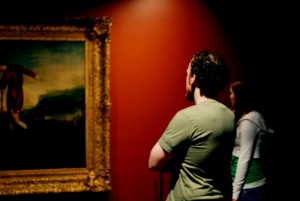What I learned From Being Among Artists: How To Take Criticism
-written by Hearth Member, Ryan Bonaparte
 For your average person, criticism is not a large part of our everyday lives. Yea, we might have a family member or a boss or a ‘frenemy’ who doles out harsh comments left and right, but rarely is it warranted. Instead, it’s often a jealous lashing out at what is in fact good work.
For your average person, criticism is not a large part of our everyday lives. Yea, we might have a family member or a boss or a ‘frenemy’ who doles out harsh comments left and right, but rarely is it warranted. Instead, it’s often a jealous lashing out at what is in fact good work.
The artist’s world, however, is different. You know how big a role criticism plays in these fields, when there is a profession solely dedicated to critiquing art work: the infamous Art Critic. There are no ‘Accounting Critics” or “Engineering Critics.” The harsh critiques in these professions are usually limited to events of catastrophic failure or gross negligence. In the business world, an investor may critique the work of a CEO, but that usually comes with the implicit ‘and executive team’ modifier attached to it. High-profile CEOs may get the blame, but everyone understands it takes more than one person to tank a company’s profits.
Another comparison would be the critics of a politician. They stand alone and speak their mind and values, but even then, many of these critiques are either based on very limited information and sound bites or fabricated to support hidden agendas.
Really the only other valid analogy would be the sports world. But yet again, even when a player falls short, there are almost as many fingers pointing at other teammates, coaches, owners, referees, equipment, etc. who failed the player along the way.
In the art world, it’s an entirely different story. Artists are almost exclusively judged on their individual contributions and with what can be scathing remarks. Just look at a few of the reviews of the latest blockbuster flop and you’ll see comments such as “laughable,” “flimsy,” and “insulting”. What makes it even worse, is that many of these artists are putting their heart and soul into these works, only to be publicly shamed, sometimes by people who have no concept of what they were trying to achieve.
Rarely is the artwork blamed on their teacher, or their tools, or their environment. It’s just about them.
But such is the life of an artist, and it comes as no surprise to any aspiring artist to see their work taken apart in such ways. In fact, they probably experienced this criticism from the very beginning, when they first started to perfect their craft. They’ve also learned to throw away criticism that comes from those who are just looking to hurt their feelings and put them down.
So what can those of us who don’t regularly engage in such open and vulnerable displays of ourselves learn from this?
Like a boxer who enters into ring for the first time, we can learn to take a hit.
When you ask an artist what it is that drives them to continue after a bad show or poor review, it’s not the potential money or fame. It’s about the art itself. It’s about focusing on living true to oneself and finding an audience that will appreciate it. Or it’s about improving their abilities to the point where they feel that they are able to effectively create and convey their vision to others.
The next time you receive a harsh criticism, whether you think it was deserved or not, try to take it as an artist would: just another comment. Analyze it for what is valid and what is garbage, keeping only the valuable insight it provided about your work and about yourself.
A few questions to ask might be:
Did the person understand my intent?
What experience/qualifications do they have in this field?
Do I feel that I could have done better?
Are their ulterior motives driving this criticism?
Were there extenuating circumstances that led to poor performance?
Note that none of this is about finding a way to blame others for your work. Instead, it’s about acknowledging the fact that there are numerous viewpoints to be considered, and it’s worth taking the time to recognize this. However, if after studying the critiques you realize they are just haters, let them slide by without another thought.
